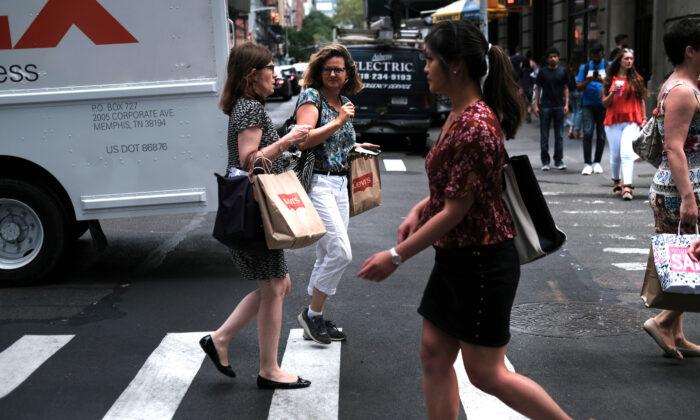WASHINGTON—There’s a strong sense among Americans that the economy is strong. Despite a falloff of economic growth last year, Americans increasingly rate the U.S. economy as the best since the dot-com boom of the late 1990s.
The U.S. economy grew 2.3 percent in 2019, the weakest annual rate since Trump took office and far short of the 3 percent growth target set by the White House.
The president, however, repeatedly pointed to the economic expansion as one of his biggest achievements, calling it “the envy of the world.”
In his address on the State of the Union on Feb. 4, Trump said, “Our economy is the best it has ever been.”
“Since my election, we have created 7 million new jobs,” he said, adding that “the average unemployment rate under my administration is lower than any administration in the history of our country.”
The U.S. economy indeed proved resilient last year, despite recession fears throughout the world that dominated the headlines. The economy entered the longest expansion in American history, surpassing the economic boom of the 1990s.
Critics argue that the economy has been doing well, but it’s not as strong as Trump has claimed, especially when compared with the economic boom of the post-war years.
While some economists caution against giving Trump too much credit, the polls suggest Americans feel content with the current state of the economy.
According to a Gallup survey last month, 59 percent of Americans say they’re better off financially today than they were a year ago, the highest since January 1999. And nearly three-quarters say they'll be better off financially in a year, the highest level of optimism recorded by Gallup.
And a Washington Post–ABC News poll showed that Trump’s approval rating on the economy hit an all-time high last month.
Consumers were central to the continued economic expansion last year, said Nathan Sheets, chief economist at PGIM Fixed Income and former undersecretary of the Treasury for international affairs under President Barack Obama.
“The core engine of the U.S. economy through this expansion, since the global financial crisis, has been the consumer, and the consumer is imperative during the year ahead,” he told The Epoch Times.
However, in order to maintain this expansion, a strong jobs market with “at least some moderate wage gains” has to continue, he said.
Strong Balance Sheet
The U.S. consumer landscape has changed dramatically since the 2008 financial crisis. Lower debt levels and a higher savings rate compared to pre-crisis levels have contributed to a more stable expansion, Sheets said.Household debt dropped sharply after the financial crisis, and it has continued to fall, as a share of gross domestic product.
Despite rising spending in the last few years, consumers have managed to keep a strong balance sheet, and this has reduced risks stemming from changing credit conditions and interest-rate increases, such as those imposed by the Federal Reserve from 2015 to 2018.
“So it doesn’t feel like we’re running out of gas in the tank for the consumer,” Sheets said.
The spread of COVID-19, however, poses a growing risk to the U.S. economy, he said. “I expect it is going to be primarily a first-quarter shock. And then as the year progresses, we'll largely make it up, and the growth for the year as a whole will be a little lower, but not substantially.”
Increasing reports of COVID-19 outside mainland China are putting pressure on global financial markets, and the Fed is still assessing the potential economic impact of the virus on the U.S. economy.
The disruption in China could spill over to the rest of the world, Fed Vice Chairman Richard Clarida said on Feb. 25 at a conference in Washington.
However, it’s “too soon to even speculate” about the impact on the economic outlook, Clarida said.
Despite risks to the outlook, “the U.S. economy is in a good place. The labor market remains strong,” he said.
‘Amazing Time’ to Launch Business
Increased hiring and rising wages have powered consumer spending, which accounts for more than two-thirds of the U.S. economy.The slowdown in global growth and trade tensions, however, weighed on business investment, exports, and manufacturing in the United States.
The trade dispute with China hasn’t affected consumer spending. Despite tariffs on Chinese imports, changes in retail prices have kept pace with broader inflation, mainly due to China’s devaluation of its currency, according to economists.
The stock market also rose steadily since Trump took office, boosting household income and allowing people to spend more.
“Continued solid job gains and lower mortgage rates and gas prices are still supporting consumer confidence,” Scott Anderson, chief economist of Bank of the West, part of BNP Paribas, wrote in a report.
Another factor in driving consumer spending is the rising pay for low-income workers.
“Over the past two years, wage growth at the bottom has been substantially faster than that in better-paying industries,” boosting consumption, The Economist reported.
William Taylor, career development manager at recruiting company Velvet Jobs, based in Los Angeles, said he benefited from the job market boom, “as there are more job opportunities now.”
The trend of flexible working and freelancing is on the rise, he told The Epoch Times.
“I believe this is one of the reasons why the unemployment rate is at its lowest right now. As people now have multiple options to choose from, I can see companies offering better wages to retain and attract top talent,” Taylor said.
The last few years have been an “amazing time” to launch a new business in the United States, said Ian Wright, who’s originally from London. Wright owns a business called Fleet Logging, which provides tracking, management, and logging solutions for the U.S. trucking industry.
“The good economy has allowed us to profitably grow our business, so it’s been really positive,” he said.





